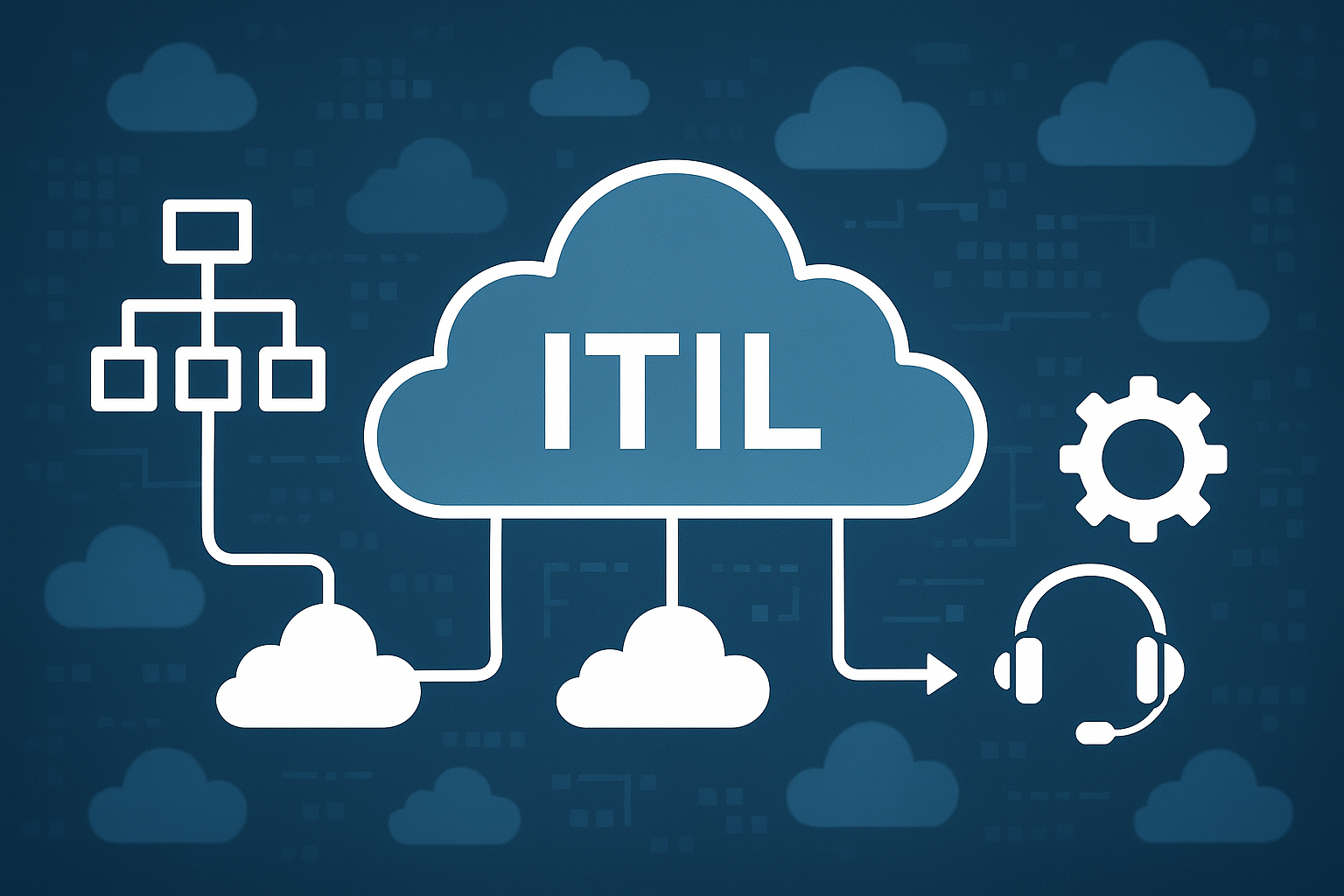
July 18, 2025
What CloudOps Costs SMBs: Pricing Breakdown and Budget Planning
Managing cloud operations today feels like running a high-speed train on unfinished tracks. You need to move quickly, release updates frequently, and address problems promptly.
But when systems break down, changes create conflicts, and issues keep recurring, your CloudOps team isn’t growing; it’s just trying to get by.
The main issue? Most CloudOps setups lack organization.
This is where ITIL comes in. It is not just a bureaucratic hurdle; it’s a proven framework that helps bring order to chaos.
At KnackForge, we have helped businesses in various industries improve their cloud environments by combining CloudOps speed with ITIL’s strong structure. This is how it works in practice—and why your business might need it now.
What is ITIL?
ITIL (Information Technology Infrastructure Library) is a globally recognized framework of best practices for IT service management (ITSM).
Its core purpose is to help organizations align their IT services with business objectives, optimize value from IT investments, and standardize service delivery and support processes
How Does ITIL Work?
ITIL is built around the concept of the service lifecycle. This lifecycle consists of five main stages, each designed to guide organizations from strategic planning to continual improvement:
1. Service Strategy
• Understand business needs and define IT service offerings.
• Align IT activities and investments with organizational goals.
2. Service Design
• Architect and design IT services, including SLAs (service level agreements), security, and availability.
3. Service Transition
• Build, test, and deploy new or modified services.
• Ensure smooth and controlled transitions through effective change management.
4. Service Operation
• Manage daily operations, incident and problem resolution, and ensure services run smoothly.
5. Continual Service Improvement
• Use feedback and performance data to refine and enhance services over time.
This structured approach enables organizations to deliver IT services in a repeatable, measurable, and reliable manner.
Why ITIL Still Matters for Cloud Operations
Before we dive into dollars and cents, a quick reminder of why ITIL is still relevant. ITIL’s service lifecycle – Service Strategy, Design, Transition, Operation, and Continual Service Improvement – offers a repeatable way to deliver IT services. In CloudOps, this translates into:
1. Standardized incident, change and problem management that reduces outages and helps you learn from mistakes.
2. Governance and accountability with clear roles and responsibilities, which is critical in hybrid or multi‑cloud setups.
3. Cost control through disciplined tracking of usage and establishing service‑level agreements (SLAs).
4. Risk management and compliance using documented controls for data security, disaster recovery and audit readiness.
5. Scalability where processes scale as quickly as your infrastructure.
Those aren’t just buzzwords – they’re the foundation for cost‑effective operations. But once that foundation is in place, you need to understand how the cloud billing meter runs.
Incident Management: From Firefighting to Fireproofing
Most incident management is reactionary. Notifications flood your inbox, teams communicate on Slack, and decisions are made under pressure. Your team spends all day putting out fires, but another outage is always on the horizon.
With ITIL-driven CloudOps, incident management can be proactive instead of reactive. Here’s how:
1. Centralized logging and alerting means you won’t miss any signals.
2. Categorizing and prioritizing incidents ensures that the most important issues get addressed first.
3. Having clear escalation paths helps speed up resolutions without delays.
Real-World Example
One of our clients, a large company in the Fortune 500, faced major challenges during a complex database migration to AWS. They had multiple MySQL nodes, a mix of different vendors, and no formal processes for managing changes or incidents. This made the migration seem impossible.
To solve these issues, we used ITIL-driven CloudOps strategies. We created clear cutover plans, set up real-time monitoring, and established rollback options, along with support that meets service level agreements (SLAs). This helped us achieve a smooth transition to Aurora MySQL 8. Now, KnackForge’s Managed Services provide 24/7 cloud support for them, ensuring their system's uptime, tuning performance, and optimizing the cloud continuously.
This is what structured CloudOps looks like: proactive, predictable, and business-ready.
Change Management: Fast Doesn’t Have to Mean Fragile
In the cloud, change happens all the time. New features, updates to infrastructure, and changes in configuration occur daily. Without proper governance, each change can become risky.
ITIL’s change management helps manage this chaos effectively.
1. Change Advisory Boards (CAB) assess risks before issues arise.
2. Change Calendars helps avoid conflicts and overlaps during deployment.
3. Standard Change Models speed up low-risk updates without delays.
This approach does not slow us down. Instead, it provides clarity. Your team knows what changes are happening, when they occur, and why they are necessary.
With ITIL-aligned CloudOps, you’re not avoiding change; you’re mastering it. it.
Problem Management: Solve It Once, Solve It Right
Here’s the key point: your team might be dealing with the same issue repeatedly, without realizing it. Incidents are just signs of a deeper problem. This is where ITIL’s problem management shines:
1. Root cause analysis (RCA) removes the guesswork.
2. A Known Error Database (KEDB) helps respond to future incidents faster.
3. Proactive problem identification stops incidents before they start.
Key Benefits of Using ITIL for CloudOps
1. Faster incident resolution and less unplanned downtime
2. More efficient and auditable change management
3. Continuous improvement and adaptation to business needs
4. Improved user and customer satisfaction with services
5. Easier regulatory compliance and readiness for audits
Key Factors Influencing CloudOps Costs for SMBs
CloudOps costs are not a one-size-fits-all number. They are highly dependent on several factors:
1. Cloud Provider: The "big three" providers (Amazon Web Services, Microsoft Azure, and Google Cloud) have different pricing structures, as do smaller, more niche providers.
2. Services Used: Costs are broken down by the specific services you consume, such as:
- Compute: The virtual machines (VMs) or containers you use to run your applications.
- Storage: The amount of data you store, the type of storage (e.g., standard, archival), and how often you access it.
- Networking: Data transfer in and out of the cloud (data egress is often a significant cost), and traffic between different cloud regions.
- Databases: Managed database services often have separate costs for compute, storage, and I/O operations.
3. Workload and Usage Patterns: Your costs will fluctuate based on how much and how often you use your resources. Unpredictable or "bursty" workloads often lead to higher costs on a pay-as-you-go model.
4. Managed vs. In-House: SMBs can manage their CloudOps in-house with dedicated IT staff or outsource to a Managed Service Provider (MSP).
5. Initial Migration Costs: Moving your existing IT infrastructure to the cloud can have one-time costs, including:
- Assessment and planning: $5,000 to $25,000, depending on complexity.
- Data migration: $1,000 to $5,000, based on data volume.
- Application refactoring: Modifying applications to run efficiently in the cloud can range from $20,000 to over $100,000.
Why You Need a Partner Like KnackForge
Integrating ITIL into your CloudOps isn’t a simple task. Here’s what you need to do:
1. Understand your current workflows.
2. Adapt ITIL practices to fit your tools and cloud services (like AWS, Azure, or GCP).
3. Train your teams on new roles, service level agreements (SLAs), and what’s expected of them.
This is where KnackForge can help. We don’t just give you a framework and walk away. We work with you to build CloudOps pipelines that are based on ITIL principles, tailored to your scale, compliance needs, and how quickly you release updates.
From automating incident handling to managing change advisory boards (CAB) and problem resolution reporting, we help you take control of your operations without added stress.
Key Benefits of ITIL-Driven CloudOps
1. Shorter time to fix problems and less downtime
2. Faster and safer updates
3. Clearer insight into ongoing issues
4. Readiness for audits and meeting regulations
5. More reliable and scalable cloud operations
Ready to Turn Your Cloud Chaos into Control?
Let's create a CloudOps strategy that is efficient, dependable, and follows ITIL guidelines.
👉 Schedule a free consultation with our CloudOps experts.
When your cloud is clear, your team can build for the future.
- cloud
- CloudOps
- ITIL
Want This Done the Smart Way
Similar Blogs
Similar Blogs
Want This Done the Smart Way?
Let's Connect
Ready to get started?
We'd love to talk about how we can work together
AWS CLOUDCOST
Take control of your AWS cloud costs that enables you to grow!
